Invasive Plant Management
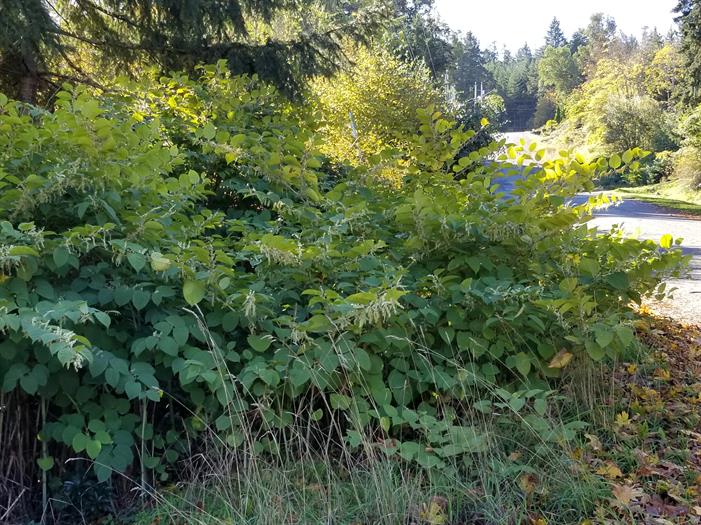
Find out about our 2024 Invasive Work Parties and Drop Zones for the month of May.
An invasive plant is a non-native plant that has the potential to negatively impact the composition, structure and function of native ecosystems.
The spread of invasive plants has become a major concern for ecologists, naturalists, residents, and land managers across British Columbia.
The City of Nanaimo is committed to preventing new invasive plants from becoming established in our parks and controlling invasive plants that pose a health concern for the public.
Partnering with a number of community volunteers, City Parks staff work to remove and manage priority invasive plants from a number of sites within our park system. Learn more about volunteering in your local park.
Invasive Plants
-
Himalayan Blackberry
Rubus armeniacus (discolour)

Goal: CONTROL
Family: Rosaceae (Rose).
Other Scientific Names: Rubus procerus, R. fruticosa, R. armeniacus.
Other Common Names: None.
Origin: Asia.
Growth Form / Reproduction: Medium to tall evergreen shrub. Seed dispersion and sprouts from root buds and stem tips.
Impacts:
Agricultural: Can establish on pastures and reduce access to grazing animals.
Ecological: Can compete with low-growing native vegetation and regenerating conifers through shade and deposits of plant litter. On stream banks and channels, large thickets replace more deeply-rooted vegetation, which may increase the risk of flooding and erosion.
Human: Dense impenetrable thickets can hinder access for recreational activities. Thickets reduce sight lines along right-of-ways. Berries are used as a food source.Habitat: Tolerates a wide range of soil moisture conditions. Well adapted to rich, well-drained soils but can grow on infertile soils of varying textures. Does best in full sun but tolerates a range of light conditions. Forms dense thickets on disturbed sites along roadsides, fence lines, pastures, forest plantations, stream banks, riparian areas, and utility corridors.
Status and Distribution: Widespread throughout the CIPC area except in Alberni-Clayoquot where it is less common. Most common in CDFmm and CWHxm but also present in CWHvm, CWHvh, CWHdm and MHmm.
Management Strategy: Control is very difficult especially on mature plants and established populations. Immediate eradication of new and small infestations should be a high priority. Hand-pulling and cutting are effective on young plants but brush cutters, weed-eaters and power saws are required for mature plants, and follow up treatments are often required. All plant material must be disposed of by burning or being deeply buried at a landfill. Several herbicides have been used with varying effectiveness. Seek professional advice when considering the use of herbicides. * The City of Nanaimo exempts the use of herbicides when managing invasive plants on residential property but encourages the use of non-chemical treatments first.
-
English Ivy
Hedera helix
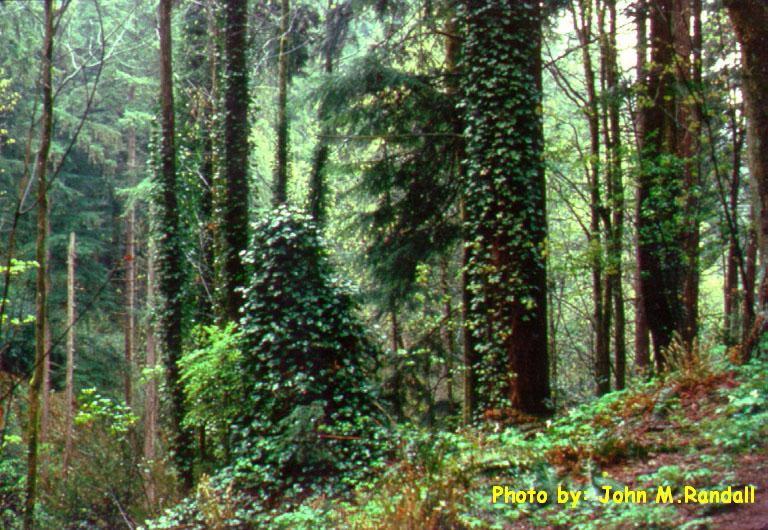
Goal: CONTROL
Family: Araliaceae (Ivy).
Other Common Names: None.
Origin: Eurasia.
Growth Form / Reproduction: Evergreen vine/shrub. Seeds dispersed by birds, also vegetatively by cuttings and rooting vines.
Impacts:
Agricultural: No information available.
Ecological: Dense patches covering the ground that shade and smother native plants and may introduce pathogens. The heavy weight of the adult stage can topple trees in wind storms.
Human: Grown as an ornamental plant. Poisonous if ingested.Habitat: Forest floors and trees at low elevations; disturbed areas. Adapted to a wide range of conditions including drought, heat and wide soil pH range. Best adapted to moist, well-drained soils in partial sun.
Status and Distribution: Present in all CIPC Regional Districts. Widespread in Mount Waddington and Strathcona and common in remaining Regional Districts. Most common in the CDFmm, CWHvm and CWHxm; also present in the CWHvh.
Management Strategy: English Ivy has two growth stages, the juvenile form where is grows as a vine along the ground, the adult form where it forms thick woody stems and grows up into trees. The vines can be hand-pulled with difficulty; treatment must be repeated many times. The upper portions of adult forms can be killed by cutting above ground. All removed portions should be disposed of at landfills and not be composted. No biocontrol agents are available.
-
Scotch Broom
Cytisus scoparius
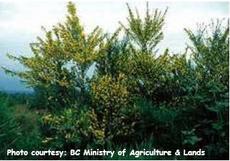
Goal: CONTROL
Scotch broom (Cytisus scoparius) is often admired as a beautiful ornamental species. With bright yellow flowers and leathery green stems, it is certainly attractive; however, it is considered a highly invasive alien plant. This woody perennial shrub can be identified by its yellow pea-like flowers that bloom in May, and flat brown seed pods.
Broom is originally from Scotland, and was brought to BC in the 1850's as a garden ornamental. Since then, this seemingly harmless plant has spread dramatically throughout the Coastal region of BC and is now moving into some areas of the Southern Interior. Scotch broom along with other broom varieties, such as Spanish broom (Spartium junceum), “jump the garden fence” invading roadsides and sensitive ecosystems throughout Vancouver Island and surrounding Coastal communities.
This seemingly harmless ornamentals is aggressive and damaging to our natural environment. Residents are encouraged to remove plants on their property. Small seedlings (less than a pencil width) can be pulled when the soil is moist. Larger plants must be cut down, preferably in May when the flowers are out but have not yet gone to seed. It is important to try to prevent plants from going to seed as this is the major method of spread. Broom does not grow well in shade, so to prevent mature stalks from re-growing; the cut stumps should be covered with plastic to prevent light access. It is also important to remove cut plant material from desirable areas as these old plant parts will release toxins into the soil that prevent re-establishment of desirable plants.
-
English Hawthorn
Crataegus monogyna
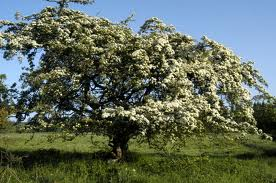
Goal: CONTAIN
Name: English Hawthorn (Crataegus monogyna)
Common Names: Common Hawthorn, One-Seed Hawthorn, May-Tree
Origin: Europe and Britain
How to recognize it: English Hawthorn is a deciduous tree or shrub 2 to 10 metres tall with a short trunk, many branches, dense leaves and short, stout thorns. It has dark grey-brown bark with smooth greyish to reddish-brown twigs. New shoots and leaves are a reddish colour and deeply lobed. Their flowers are creamy-white that produce clumps of scarlet fruits that stay on the tree over winter. English Hawthorn is found in lowland areas on many soil types but prefers moist to damp disturbed places such as thickets, wetlands, lake margins and open forests. It appears to thrive best in deeper soils.
Impact on humans and the environment: English Hawthorn can replace open grassland habitat with a dense shrub and small tree layer dramatically changing the composition of the plant community. By shutting out much of the light to the ground, it eliminates native plants and also impacts native birds, insects and other animals that rely on native plants for food and habitat. It may also harbour non-native mammals such as rabbits.
Management techniques: Seedlings can be hand pulled when the soil is moist. Young plants can be cut using a brush saw. Older trees can be cut close to the base using chain or handsaws. Cutting is most effective when about 20 percent of the flowers have gone to seed but should be avoided at this time if native plants are still flowering or setting seed. Avoid cutting when the trees are full of berries, as they will be scattered when the tree is dragged away. Roots should also be removed to prevent regeneration. Stumps can be cut with an axe to reduce resprouting. Since Hawthorn can regenerate from cuttings, cut material should be taken off site.
-
Gorse
Ulex europaeus
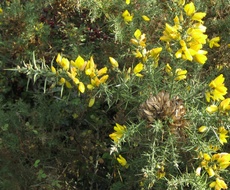
Goal: CONTAIN
Gorse (Ulex europaeus) is a spiny evergreen shrub with bright yellow pea-like flowers, resembling Scotch broom.
It grows on open clearings, coastal bluffs, logged areas, and roadsides. It is most common on southern Vancouver Island near Victoria, but also occurs on a number of Gulf Islands. Gorse out competes native vegetation, reduces access for recreation, increases fire hazard, reduces pasture growth and has the potential to impair forest regeneration in logged areas.
Gorse expands rapidly in its first 15 years and may live up to 45 years. Seeds may be dispersed by wildlife, water and machinery. Gorse can be controlled by hand-pulling young plants and cutting down mature shrubs. Care should be taken to minimize soil disturbance as dormant seeds may start germinating once exposed to light.
-
Daphne / Spurge-Laurel
Daphne laureola


Goal: CONTAIN
Family: Thymelaeaceae.
Other Common Names: Spurge Laurel, spurgelaurel.
Origin: Western Europe and Mediterranean.
Growth Form/Reproduction: Evergreen shrub. Seeds and vegetatively from lateral roots.
Impacts:
Agricultural: Information not available.
Ecological: Can form dense stands in understory of Douglas-fir forests.
Human: Seeds and leaves are very poisonous; sap is an irritant.Habitat: Found in roadsides and parks and in wooded areas, especially in the understory of Douglas-fir forests. Spurge-laurel has a wide range of ecological tolerances but appears well adapted to partial and deep shade.
Status and Distribution: Common in Capital Regional District. Limited distribution in Comox Valley, Cowichan Valley and Nanaimo Regional District.
Management Strategy: Protective clothing, gloves and eyewear required when handling spurge-laurel. Small plants can be hand-pulled while individual larger plants can be excavated. Bag and remove berries before disturbing the plant. Seek professional advice when considering the use of herbicides. * The City of Nanaimo exempts the use of herbicides when managing invasive plants on residential property but encourages the use of non-chemical treatments first. No biocontrol agent is available.
-
Japanese Knotweed
Polygonum cuspidatum

Goal: CONTAIN
Japanese knotweed is a tall shrub with bamboo-like stems. It has been planted throughout South and Central Vancouver Island and the Gulf Islands as a garden ornamental but quickly spreads to form dense thickets in a variety of habitats, including dry roadsides and moist stream banks. Small patches can quickly spread into large areas, leaving little room for native species to grow.
These plants can be identified by their tall (>3 metres), bamboo-like stem structure, leaves that are flat at the base with a pointed tip and small white flowers that bloom in late summer.
Family: Polygonaceae (Buckwheat).
Other Scientific Names: Fallopia japonica, Polygonum cuspidatum Reynoutria japonica.
Other Common Names: Fleeceflower, Huzhang, Hancock's curse, elephant ears, donkey rhubarb, Japanese bamboo, American bamboo, and Mexican bamboo.
Origin: Asia.
Growth Form / Reproduction: Deciduous perennial. Spread mainly vegetatively from rhizomes but will produce viable seed if Bohemian knotweed is nearby.
Impacts:
Agricultural: Knotweeds can be eaten by grazing animals.
Ecological: Dense stands may compete with and replace native vegetation.
Human: Knotweeds have been used as landscape ornamentals.Habitat: Adapted to moist conditions and to a variety of soil types; generally shade intolerant. Disturbed sites, roadsides, streams banks, ditches, wetlands, riparian areas, railroad and utility corridors
Status and Distribution: Widespread in all Regional Districts except Capital where it is common. Most common in CDFmm, CWHxm and CWHvm but present in CWHvh and CWHdm.
Management Strategy: Eradicate new infestation where feasible. Contain or control existing populations. Once established, knotweeds are extremely difficult to control; the rhizomes extend meters beyond the clones and they can regenerate from tiny fragments. Digging or hand-pulling can result in plants re-sprouting. Cutting, mowing, grazing and foliar herbicides can reduce top growth but repeated treatments are required for long-term control.
-
Policeman's Helmet \ Himalayan Balsam
Impatiens glandulifera
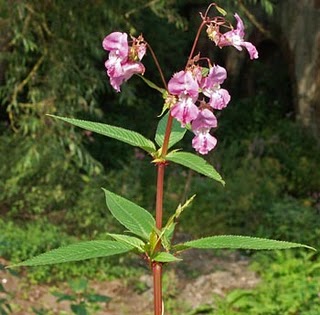
Goal: CONTAIN
Family: Balsaminaceae (Balsam or Touch-me-not).
Other Scientific Names: Impatiens roylei.
Other Common Names: Himalayan balsam, Ornamental jewelweed.
Origin: India and the western Himalaya.
Growth Form/Reproduction: Annual. Seeds; plants have explosive seed capsules.
Impacts:
Agricultural: Grazed by cattle and sheep.
Ecological: Himalayan balsam dominates vegetation of watercourses because of its tall stature (3 m), rapid growth and high seed production and dispersal. It exposes soils of stream banks to erosion once it dies back in autumn; the week root system is inadequate to protect against high winter flows.
Human: Landscape ornamental.Habitat: Partially shade tolerant. Tolerates a wide range of soil condition; requires high soil moisture. Grows from low- to mid-elevations; cold temperatures may limit distribution. Disturbed sites, roadsides, riparian areas, streambanks, and meadows.
Status and Distribution: Present in all CIPC Regional Districts; common in Comox Valley, limited in other districts. Most common in CWHxm but also reported in CDFmm and CWHvm.
Management Strategy: Eradicate or contain plants to present sites. Policeman's helmet has a shallow root system and can be easily pulled. Effective control of this plant depends on controlling seed production since seeds are catapulted through the air great distances and the buoyant seeds travel easily along watercourses. Mowing or pulling should be done before seeds appear and treatments should begin upstream. Repeated treatments are required the following year since in-ground seeds remain viable. Intensive grazing may provide efficient control but riparian areas may be damaged. No biological controls are available and chemical control.
-
Garlic Mustard
Alliaria petiolata
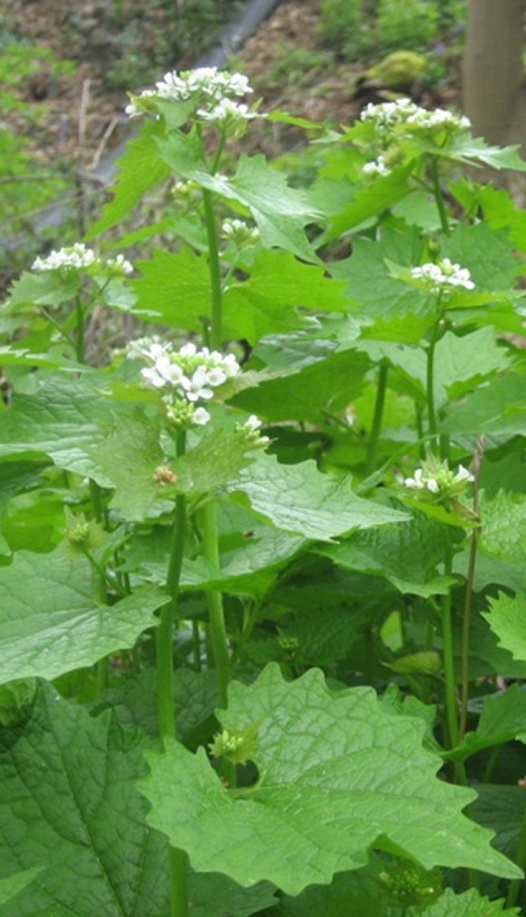
Goal: ERADICATE
Family: Brassicaceae (Mustard).
Other Common Names: Garlic root.
Origin: Europe.
Growth Form/Reproduction: Biennial/ Seeds
Impacts:
Agricultural: No information available.
Ecological: Invades and dominates understory of forested areas.
Human: Culinary and medicinal herb. No information on negative effects.Habitat: Prefers shade and moist, rich soil but tolerates full sun and a wide range of soil types. Grows in forests, riparian areas, disturbed sites, urban areas, trail edges and stream banks.
Status and Distribution: Rare on Vancouver Island
Management Strategy: In small populations, plants can be hand-pulled taking care to remove all of root system. For larger populations, cut flowering stems at or near ground level. Remove plant material from the site; seeds can continue to develop on severed plants. Glyphosate provides good control. Biocontrol is not presently available.
-
Carpet Burweed
Soliv sessilis

Goal: CONTAIN
Carpet burweed (Soliva sessilis) is an invasive broadleaf winter annual that threatens open areas in parks, golf courses and RV parks. It forms a 'carpet' in the turf, spreads easily and is difficult to identify.
Carpet burweed is a low-growing plant, measuring up to 3-5 cm in diameter and 7 cm tall. The alternate, carrot-like leaves are slightly hairy with a greenish flower head growing in the basal rosette of the leaves. The ovate, flattened achenes can be slightly hairy, with a thick spine. The horn-like seed measures 2.5-3.5 mm long with 5-10 seeds per seedhead. It is commonly mistaken for Parsley-piert, Queen Anne's lace, Pineapple weed, Dovesfoot geranium and Spring gold.
Seed spread occurs when the seed spine punctures the skin of humans and animals or attaches to animal fur/paws, footwear, clothing, maintenance or recreational equipment (i.e. tents, tarps, mowers, etc.), lawn clippings and vehicle/bike tires.Carpet burweed can be found in isolated areas on the Southern Gulf Islands and Vancouver Island, as far north as Ucluelet. Once discovered, the plant is rapidly eradicated to prevent further spread.
It can out-compete tended grasses and is unaffected by mowing due to its low-lying structure. Depending on the site, carpet burweed can be removed by hand pulling, burning or herbicide application.
Toxic Invasive Plants
-
Giant Hogweed
Heracleum mantegazzianum
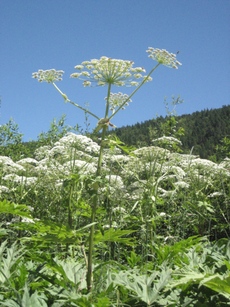
Goal: ERADICATE
Giant hogweed (Heracleum mantegazzianum) is an aggressive invader that was first introduced to North America as a garden ornamental. It closely resembles our native plant cow parsnip, except the taller giant hogweed can grow up to 6-metres or more.
Family: Apiaceae (Carrot).
Other Common Names: Giant Cow-parsnip, Hogweed.
Origin: Asia.
Growth Form / Reproduction: Herbaceous perennial. Reproduces by seeds and from perennial buds at crown.
Impacts:
Agricultural: Can infest agricultural areas.
Ecological: Strongly competitive plant; dense stands of very, tall plants outcompete native species in riparian areas. Roots are shallow compared to mixed native communities, which may increase erosion risks in riparian areas.
Human: Sap on exposed skin causes hypersensitivity to sunlight resulting in irritation, blistering and dermatitis. Scarring and blindness may result.Habitat: Adapted to rich, damp soil and tolerates a wide range of light regimes. Grows on wet to moist disturbed sites at low elevations. Inhabits streams, wetlands, ditches, roads, right-of-ways, agricultural areas, wooded ravines, vacant lots, and other disturbed sites.
Status and Distribution: Present in all CIPC Regional Districts. Widespread in Nanaimo, common in Comox Valley, Cowichan Valley and Strathcona. Limited in Alberni-Clayoquot, Capital and Powell River. Most common in CDFmm and CWHxm but also reported in CWHvm and CWHvh.
Management Strategy: Use protective clothing and eyewear when handling this plant. Cut off flowers to prevent seed formation. Excavate plants, severing roots 8-12 cm below the soil surface. Do not compost; dispose of all plant parts in strong garbage bags. Return to site to check for regrowth. Immature plants can be controlled by covering with black plastic or by mowing at 2 week intervals; 3-5 years of follow-up treatment may be required. Chemical controls can be effective. Foliar applications are most effective in spring followed by a summer application on late appearing sprouts. Stem injections or cut stem and injections are effective after heavy sap flow in spring. No biological control agents are available.
-
Poison Hemlock
Conium maculatum
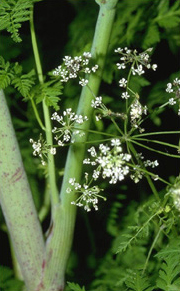
Goal: ERADICATE
Poison Hemlock (Conium maculatum) is an aggressive invader that is found in wet to mesic habitats in the lowland zone and is locally common in southwest BC, particularly in the Vancouver and Victoria areas.
Family: Apiaceae (Parsley).
Other Common Names: Hemlock
Origin: Europe
Growth Form / Reproduction: Biennial forb.
Impacts:
Agricultural: Poison hemlock crowds out desirable forage species and can poison livestock and humans. Sheep are less sensitive to it than cattle and horses.
Ecological: Although not an aggressive invader, poison hemlock may gradually increase in riparian and lowland communities.
Human: All parts of the plant are highly poisonous and poison hemlock should be handled with care.Habitat: Poison hemlock is generally found on dry to moist soils, can tolerate poorly drained soils, and tends to be scattered in riparian areas. It is usually found along streams, irrigation ditches, and the borders of pastures and cropland, and it can gradually invade perennial crops.
Status and Distribution: In BC it is found in wet to mesic habitats in the lowland zone and is locally common in the southwest of the province, particularly in the
Vancouver and Victoria areas. It is present in the Kootenay, Okanagan, Mainland, Vancouver Island, and Cariboo regions.Management Strategy: Biocontrol: Agonopterix alstroemeriana (moth), accidentally introduced into the US, apparently feeds exclusively on poison hemlock. It is found in Colorado and is a biological control agent in Idaho, Oregon, and Washington, where it is effective (William et al. 1996). This species has not been found in BC.
Mechanical: Poison hemlock can be controlled by digging, repeated mowing, pulling, or spring/winter burns. Care should be taken to avoid contact with bare skin (wear gloves). Wash hands thoroughly after handling any part of this plant.
Fire: No information available.
Herbicides: Picloram, dicamba, 2,4-D, and glyphosate have been used for chemical control of poison hemlock. Apply foliar herbicides during the rosette stage with a wick to minimize damage to adjacent desirable vegetation. Cut any stems that arise after treatment. Herbicide treatment may need to be repeated for several years until the seed bank is depleted (Panter and Keeler 1988). Consult the most recent edition of BC Ministry of Agriculture, Food and Fisheries Crop Production Guides for specific recommendations.
Source:
Government of British Columbia. 2002. A Guide to Weeds in British Columbia. Crown Publications.
To Learn More
- City of Nanaimo Invasive Plant Management Strategy
- Coastal Invasive Species Committee
- Invasive Species Committee of British Columbia
- Invasive Alien Plant Program (Province of BC)
- Download the "Report a Weed" Mobile App
- Identify Weeds and Invasive Plants (King County, Washington State)
- Broom Busters
Take Action
A great opportunity to meet new people, get some great exercise and help protect and preserve our parks for the future.
Last updated: November 13, 2024
Help us improve our website
Collection and use of your personal information
Information collected on this form is done so under the general authority of the Community Charter and
Freedom of Information and Protection of Privacy Act (FOIPPA), and is protected in accordance with FOIPPA. Questions about the collection of your personal information may be referred to the Legislative Services Department at 250-755-4405, or via email at foi@nanaimo.ca. Please also see our Privacy Policy.
-
Parks, Rec & Culture
- Recreation Facilities & Schedules
- Parks & Trails
- Activity Guide
- Events
- Register for a Program
- Drop-In Schedules
- Public Art
- Culture
- Poetry
-
City Services
- Garbage & Recycling
- Home & Property
- Water & Sewage
- Emergency Services
- Online Services
- Cemetery Services
- City Services Directory
-
Property & Development
- Urban Forestry
-
Building Permits
- Online Building Permit Application
- Building Permit Revision
-
Application for a Residential Building Permit
- Access (driveway) Permit
- Accessory Building Permit
- Alteration Permit
- Building Envelope Repair
- Carriage House
- Demolition Permit
- Fence or Retaining Wall Permit
- Geotechnical Reports
- Locate Permit
- New Construction Permit
- Plumbing or Services Permit
- Secondary Suite Permit
- Special Inspection Permit
- Swimming Pool Permit
- Woodstove Installation Info
- Green Home Initiatives
-
Apply for a Commercial Building Permit
- Access (driveway) Permit
- Commercial Alteration Permit
- Building Envelope Repair Permit
- Demolition Permit
- Fence or Retaining Wall Permit
- Geotechnical Reports
- Leasehold Improvement
- Locate Permit
- New Commercial Construction Permit
- Occupant Load Permit
- Signs Permit
- Special Inspection Permit
- Sprinkler Requirements
- Fees and Bonding
- Commercial Plumbing Permit
- Bylaws for Building
- Forms and Guidelines
- Book a Building Inspection
- Report Illegal Construction
- Request Building Plans
- Building Permit Statistics
- Permit Fee Calculator
- Building News and Alerts
- Fast Track Building Permits
- Development Applications
- What's Building in my Neighbourhood
- Development Activity Map
- Community Planning
- NanaimoMap
- Rebates
- Engineering Survey
- Land Use Bylaws
- Soil Removal and Depositing
- Heritage Buildings
- Sustainability
- Transportation & Mobility
-
Your Government
- Government Services Guide
- News & Events
-
City Council
- Advocacy
- Contact Mayor & Council
- Council Meetings
-
Boards & Committees
- Advisory Committee on Accessibility and Inclusiveness
- Board of Variance
- Design Advisory Panel
- Finance and Audit Committee
- Governance and Priorities Committee
- Mayor's Leaders' Table
- Nanaimo Performing Arts Guild
- Parcel Tax Roll Review Panel
- Special District 68 Sports Field and Recreation Committee
- Public Safety Committee
- Understanding Council Committee Structures
- Council Policies
- Mayor's Office
- Council Initiatives
- Proclamations
- Bastion Lighting Requests
- Alternative Approval Process
- Budget & Finance
- Records, Information & Privacy
- Elections
- Contacts
- Careers
- Maps & Data
- Projects
- Tourism Nanaimo
- Grants
- Awards
- Accessibility & Inclusion
-
Doing Business
- Economic Development
- Doing Business with the City
- Business Licences
- Filming in Nanaimo
- City Owned Property
- Encroachments onto City Property
- Liquor Licences
- Cannabis Retail
- Business Improvement Areas
- Procurement Services
- Get Involved
- About Nanaimo
- Green Initiatives
-
Public Safety
- Public Safety Contacts
- Nanaimo Fire Rescue
- Emergency Management
- Police & Crime Prevention
- City Bylaws
- Community Safety and Wellbeing

